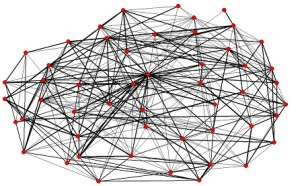Identifying Talent is a top priority in any organistion today. Daniel Pink, in his TED talk on The Surprising Science of Motivation, suggests the most valuable people in a knowledge economy organizations are the people thinking about solutions to to questions we haven’t even discovered / asked yet. I’m not sure that’s possible, but it certainly describes the sort of person we should be identifying, developing and holding onto.
But how do we do that accurately in a knowledge economy? Peter Drucker weighs in with:
“Evaluating the performance of knowledge workers is an almost impossible task, as much of their work takes place inside of their heads.”
In a paper by Eoin Whelan, from the University of Limerick, titled ‘It’s Whom You Know Not What You Know: A Social Network Analysis Approach to Talent Management‘, he suggests that performance appraisals are the most commonly used mechanisms to identify A-Players, and yet evidence that points to the deficiencies of such metrics is plentiful in supply. He suggests at least two reasons:
For example, individual appraisals can lead to an over emphasis on individual performance which undermines teamwork and has the potential to create destructive internal competition (Pfeffer, 2001). Likewise, there is much evidence which confirms rater bias in performance appraisals. Employees who share similarities with their supervisor tend to receive higher ratings (Tsui et al., 2002) and are more likely to receive promotions (Wakabayashi et al.,1988). For these reasons, it has been argued that the use of such metrics are problematic when applied to the management of talented people (Makela et al., 2010, Mellahi and Collings, 2010, Gladwell, 2002).
But what if it’s not what lies inside that counts? What if talent has more to do with relationships someone has, and the position they occupy in the networks they belong to? If there is some truth to this, it would require a completely different approach and set of tools to measure and identify talent.
Social Network Analysis (SNA) would be one such tool. Wikipedia has the following to say in defining SNA:
Social networks have also been used to examine how organizations interact with each other, characterizing the many informal connections that link executives together, as well as associations and connections between individual employees at different organizations. For example, power within organizations often comes more from the degree to which an individual within a network is at the center of many relationships than actual job title. Social networks also play a key role in hiring, in business success, and in job performance.
 Of course it’s not as simple as the above paragraph. Work needs to be done to properly understand any network you examine and the roles of the individuals within those networks. SNA allows us to understand better how a network responds to the individuals within it and visa versa.
Of course it’s not as simple as the above paragraph. Work needs to be done to properly understand any network you examine and the roles of the individuals within those networks. SNA allows us to understand better how a network responds to the individuals within it and visa versa.
Perhaps a useful and popular platform to illustrate this is FaceBook. When analyzing one of your connection’s (aka Friend) network you can see who has connected with them, how many people, and perhaps even get a sense of why they have made the connection? The real world is different to the digital world in this regard. We are less likely to ‘Friend’ people we don’t find useful or interesting to us in the real world. What our connections have to say about us, or the amount of energy we give or take-away from them, or whether they use us to find solutions for their projects or not does say much about who we are.
I am often astounded at the results SNA delivers when working with a team of people. I have always been surprised at how much information can be gathered from an often very simple process. I certainly think SNA is an under-utilised tool for identifying talent. It draws on the ‘Wisdom of Crowds’ and gets away from the subjectivity often attached to deciding who is and isn’t talent?
It does come with risks, which is possibly why it’s not employed more often:
- It can cut fairly deep and deliver some robust insight to individuals and the team. Courage is often needed to embark on an SNA journey.
- It shifts control and responsibility from manager/leader to the voice of the group, and may possibly include difficult feedback for said manager/leader.
Whatever the reason it’s not used more, it’s a much needed tool in the identification of talent in any organisation.


